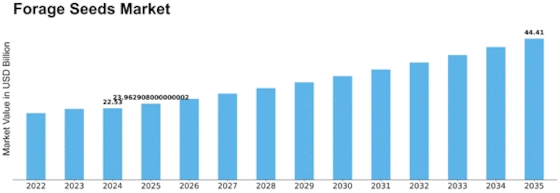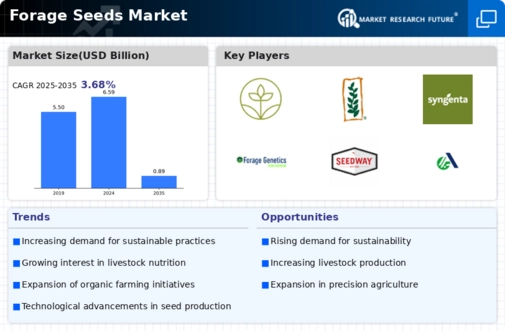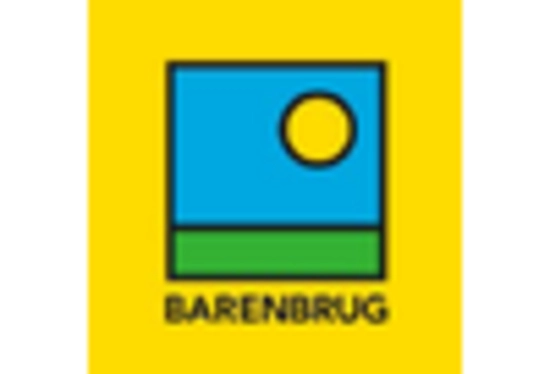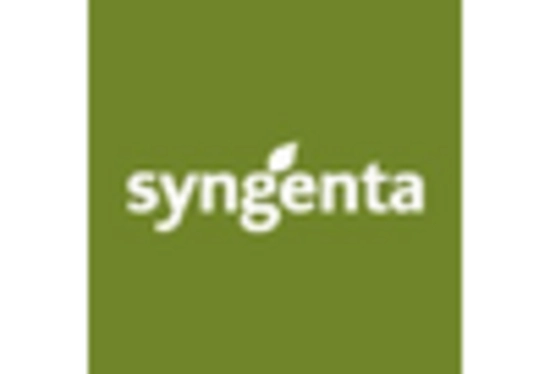-
EXECUTIVE SUMMARY
-
Market Overview
-
Key Findings
-
Market Segmentation
-
Competitive Landscape
-
Challenges and Opportunities
-
Future Outlook
-
MARKET INTRODUCTION
-
Definition
-
Scope of the study
- Research Objective
- Assumption
- Limitations
-
RESEARCH METHODOLOGY
-
Overview
-
Data Mining
-
Secondary Research
-
Primary Research
- Primary Interviews and Information Gathering Process
- Breakdown of Primary Respondents
-
Forecasting Model
-
Market Size Estimation
- Bottom-Up Approach
- Top-Down Approach
-
Data Triangulation
-
Validation
-
MARKET DYNAMICS
-
Overview
-
Drivers
-
Restraints
-
Opportunities
-
MARKET FACTOR ANALYSIS
-
Value chain Analysis
-
Porter's Five Forces Analysis
- Bargaining Power of Suppliers
- Bargaining Power of Buyers
- Threat of New Entrants
- Threat of Substitutes
- Intensity of Rivalry
-
COVID-19 Impact Analysis
- Market Impact Analysis
- Regional Impact
- Opportunity and Threat Analysis
-
FORAGE SEEDS MARKET, BY CROP TYPE (USD BILLION)
-
Legumes
-
Grasses
-
Cereal Forages
-
FORAGE SEEDS MARKET, BY END USE (USD BILLION)
-
Animal Feed
-
Soil Erosion Control
-
Biofuel Production
-
FORAGE SEEDS MARKET, BY FORM (USD BILLION)
-
Seed Pellets
-
Raw Seeds
-
Processed Seeds
-
FORAGE SEEDS MARKET, BY DISTRIBUTION CHANNEL (USD BILLION)
-
Online
-
Offline
-
Direct Sales
-
FORAGE SEEDS MARKET, BY REGIONAL (USD BILLION)
-
North America
- US
- Canada
-
Europe
- Germany
- UK
- France
- Russia
- Italy
- Spain
- Rest of Europe
-
APAC
- China
- India
- Japan
- South Korea
- Malaysia
- Thailand
- Indonesia
- Rest of APAC
-
South America
- Brazil
- Mexico
- Argentina
- Rest of South America
-
MEA
- GCC Countries
- South Africa
- Rest of MEA
-
COMPETITIVE LANDSCAPE
-
Overview
-
Competitive Analysis
-
Market share Analysis
-
Major Growth Strategy in the Forage Seeds Market
-
Competitive Benchmarking
-
Leading Players in Terms of Number of Developments in the Forage Seeds Market
-
Key developments and growth strategies
- New Product Launch/Service Deployment
- Merger & Acquisitions
- Joint Ventures
-
Major Players Financial Matrix
- Sales and Operating Income
- Major Players R&D Expenditure. 2023
-
COMPANY PROFILES
-
GrainCorp
- Financial Overview
- Products Offered
- Key Developments
- SWOT Analysis
- Key Strategies
-
Nature's Seed
- Financial Overview
- Products Offered
- Key Developments
- SWOT Analysis
- Key Strategies
-
Sakata Seed Corporation
- Financial Overview
- Products Offered
- Key Developments
- SWOT Analysis
- Key Strategies
-
Monsanto
- Financial Overview
- Products Offered
- Key Developments
- SWOT Analysis
- Key Strategies
-
Syngenta
- Financial Overview
- Products Offered
- Key Developments
- SWOT Analysis
- Key Strategies
-
Forage Genetics International
- Financial Overview
- Products Offered
- Key Developments
- SWOT Analysis
- Key Strategies
-
Hancock Seed Company
- Financial Overview
- Products Offered
- Key Developments
- SWOT Analysis
- Key Strategies
-
Seedway
- Financial Overview
- Products Offered
- Key Developments
- SWOT Analysis
- Key Strategies
-
Advanta Seeds
- Financial Overview
- Products Offered
- Key Developments
- SWOT Analysis
- Key Strategies
-
BASF
- Financial Overview
- Products Offered
- Key Developments
- SWOT Analysis
- Key Strategies
-
Bayer
- Financial Overview
- Products Offered
- Key Developments
- SWOT Analysis
- Key Strategies
-
Pioneer HiBred
- Financial Overview
- Products Offered
- Key Developments
- SWOT Analysis
- Key Strategies
-
DLF
- Financial Overview
- Products Offered
- Key Developments
- SWOT Analysis
- Key Strategies
-
Corteva Agriscience
- Financial Overview
- Products Offered
- Key Developments
- SWOT Analysis
- Key Strategies
-
Barenbrug
- Financial Overview
- Products Offered
- Key Developments
- SWOT Analysis
- Key Strategies
-
APPENDIX
-
References
-
Related Reports
-
LIST OF TABLES
-
LIST OF ASSUMPTIONS
-
NORTH AMERICA FORAGE SEEDS MARKET SIZE ESTIMATES & FORECAST, BY CROP TYPE, 2019-2035 (USD BILLIONS)
-
NORTH AMERICA FORAGE SEEDS MARKET SIZE ESTIMATES & FORECAST, BY END USE, 2019-2035 (USD BILLIONS)
-
NORTH AMERICA FORAGE SEEDS MARKET SIZE ESTIMATES & FORECAST, BY FORM, 2019-2035 (USD BILLIONS)
-
NORTH AMERICA FORAGE SEEDS MARKET SIZE ESTIMATES & FORECAST, BY DISTRIBUTION CHANNEL, 2019-2035 (USD BILLIONS)
-
NORTH AMERICA FORAGE SEEDS MARKET SIZE ESTIMATES & FORECAST, BY REGIONAL, 2019-2035 (USD BILLIONS)
-
US FORAGE SEEDS MARKET SIZE ESTIMATES & FORECAST, BY CROP TYPE, 2019-2035 (USD BILLIONS)
-
US FORAGE SEEDS MARKET SIZE ESTIMATES & FORECAST, BY END USE, 2019-2035 (USD BILLIONS)
-
US FORAGE SEEDS MARKET SIZE ESTIMATES & FORECAST, BY FORM, 2019-2035 (USD BILLIONS)
-
US FORAGE SEEDS MARKET SIZE ESTIMATES & FORECAST, BY DISTRIBUTION CHANNEL, 2019-2035 (USD BILLIONS)
-
US FORAGE SEEDS MARKET SIZE ESTIMATES & FORECAST, BY REGIONAL, 2019-2035 (USD BILLIONS)
-
CANADA FORAGE SEEDS MARKET SIZE ESTIMATES & FORECAST, BY CROP TYPE, 2019-2035 (USD BILLIONS)
-
CANADA FORAGE SEEDS MARKET SIZE ESTIMATES & FORECAST, BY END USE, 2019-2035 (USD BILLIONS)
-
CANADA FORAGE SEEDS MARKET SIZE ESTIMATES & FORECAST, BY FORM, 2019-2035 (USD BILLIONS)
-
CANADA FORAGE SEEDS MARKET SIZE ESTIMATES & FORECAST, BY DISTRIBUTION CHANNEL, 2019-2035 (USD BILLIONS)
-
CANADA FORAGE SEEDS MARKET SIZE ESTIMATES & FORECAST, BY REGIONAL, 2019-2035 (USD BILLIONS)
-
EUROPE FORAGE SEEDS MARKET SIZE ESTIMATES & FORECAST, BY CROP TYPE, 2019-2035 (USD BILLIONS)
-
EUROPE FORAGE SEEDS MARKET SIZE ESTIMATES & FORECAST, BY END USE, 2019-2035 (USD BILLIONS)
-
EUROPE FORAGE SEEDS MARKET SIZE ESTIMATES & FORECAST, BY FORM, 2019-2035 (USD BILLIONS)
-
EUROPE FORAGE SEEDS MARKET SIZE ESTIMATES & FORECAST, BY DISTRIBUTION CHANNEL, 2019-2035 (USD BILLIONS)
-
EUROPE FORAGE SEEDS MARKET SIZE ESTIMATES & FORECAST, BY REGIONAL, 2019-2035 (USD BILLIONS)
-
GERMANY FORAGE SEEDS MARKET SIZE ESTIMATES & FORECAST, BY CROP TYPE, 2019-2035 (USD BILLIONS)
-
GERMANY FORAGE SEEDS MARKET SIZE ESTIMATES & FORECAST, BY END USE, 2019-2035 (USD BILLIONS)
-
GERMANY FORAGE SEEDS MARKET SIZE ESTIMATES & FORECAST, BY FORM, 2019-2035 (USD BILLIONS)
-
GERMANY FORAGE SEEDS MARKET SIZE ESTIMATES & FORECAST, BY DISTRIBUTION CHANNEL, 2019-2035 (USD BILLIONS)
-
GERMANY FORAGE SEEDS MARKET SIZE ESTIMATES & FORECAST, BY REGIONAL, 2019-2035 (USD BILLIONS)
-
UK FORAGE SEEDS MARKET SIZE ESTIMATES & FORECAST, BY CROP TYPE, 2019-2035 (USD BILLIONS)
-
UK FORAGE SEEDS MARKET SIZE ESTIMATES & FORECAST, BY END USE, 2019-2035 (USD BILLIONS)
-
UK FORAGE SEEDS MARKET SIZE ESTIMATES & FORECAST, BY FORM, 2019-2035 (USD BILLIONS)
-
UK FORAGE SEEDS MARKET SIZE ESTIMATES & FORECAST, BY DISTRIBUTION CHANNEL, 2019-2035 (USD BILLIONS)
-
UK FORAGE SEEDS MARKET SIZE ESTIMATES & FORECAST, BY REGIONAL, 2019-2035 (USD BILLIONS)
-
FRANCE FORAGE SEEDS MARKET SIZE ESTIMATES & FORECAST, BY CROP TYPE, 2019-2035 (USD BILLIONS)
-
FRANCE FORAGE SEEDS MARKET SIZE ESTIMATES & FORECAST, BY END USE, 2019-2035 (USD BILLIONS)
-
FRANCE FORAGE SEEDS MARKET SIZE ESTIMATES & FORECAST, BY FORM, 2019-2035 (USD BILLIONS)
-
FRANCE FORAGE SEEDS MARKET SIZE ESTIMATES & FORECAST, BY DISTRIBUTION CHANNEL, 2019-2035 (USD BILLIONS)
-
FRANCE FORAGE SEEDS MARKET SIZE ESTIMATES & FORECAST, BY REGIONAL, 2019-2035 (USD BILLIONS)
-
RUSSIA FORAGE SEEDS MARKET SIZE ESTIMATES & FORECAST, BY CROP TYPE, 2019-2035 (USD BILLIONS)
-
RUSSIA FORAGE SEEDS MARKET SIZE ESTIMATES & FORECAST, BY END USE, 2019-2035 (USD BILLIONS)
-
RUSSIA FORAGE SEEDS MARKET SIZE ESTIMATES & FORECAST, BY FORM, 2019-2035 (USD BILLIONS)
-
RUSSIA FORAGE SEEDS MARKET SIZE ESTIMATES & FORECAST, BY DISTRIBUTION CHANNEL, 2019-2035 (USD BILLIONS)
-
RUSSIA FORAGE SEEDS MARKET SIZE ESTIMATES & FORECAST, BY REGIONAL, 2019-2035 (USD BILLIONS)
-
ITALY FORAGE SEEDS MARKET SIZE ESTIMATES & FORECAST, BY CROP TYPE, 2019-2035 (USD BILLIONS)
-
ITALY FORAGE SEEDS MARKET SIZE ESTIMATES & FORECAST, BY END USE, 2019-2035 (USD BILLIONS)
-
ITALY FORAGE SEEDS MARKET SIZE ESTIMATES & FORECAST, BY FORM, 2019-2035 (USD BILLIONS)
-
ITALY FORAGE SEEDS MARKET SIZE ESTIMATES & FORECAST, BY DISTRIBUTION CHANNEL, 2019-2035 (USD BILLIONS)
-
ITALY FORAGE SEEDS MARKET SIZE ESTIMATES & FORECAST, BY REGIONAL, 2019-2035 (USD BILLIONS)
-
SPAIN FORAGE SEEDS MARKET SIZE ESTIMATES & FORECAST, BY CROP TYPE, 2019-2035 (USD BILLIONS)
-
SPAIN FORAGE SEEDS MARKET SIZE ESTIMATES & FORECAST, BY END USE, 2019-2035 (USD BILLIONS)
-
SPAIN FORAGE SEEDS MARKET SIZE ESTIMATES & FORECAST, BY FORM, 2019-2035 (USD BILLIONS)
-
SPAIN FORAGE SEEDS MARKET SIZE ESTIMATES & FORECAST, BY DISTRIBUTION CHANNEL, 2019-2035 (USD BILLIONS)
-
SPAIN FORAGE SEEDS MARKET SIZE ESTIMATES & FORECAST, BY REGIONAL, 2019-2035 (USD BILLIONS)
-
REST OF EUROPE FORAGE SEEDS MARKET SIZE ESTIMATES & FORECAST, BY CROP TYPE, 2019-2035 (USD BILLIONS)
-
REST OF EUROPE FORAGE SEEDS MARKET SIZE ESTIMATES & FORECAST, BY END USE, 2019-2035 (USD BILLIONS)
-
REST OF EUROPE FORAGE SEEDS MARKET SIZE ESTIMATES & FORECAST, BY FORM, 2019-2035 (USD BILLIONS)
-
REST OF EUROPE FORAGE SEEDS MARKET SIZE ESTIMATES & FORECAST, BY DISTRIBUTION CHANNEL, 2019-2035 (USD BILLIONS)
-
REST OF EUROPE FORAGE SEEDS MARKET SIZE ESTIMATES & FORECAST, BY REGIONAL, 2019-2035 (USD BILLIONS)
-
APAC FORAGE SEEDS MARKET SIZE ESTIMATES & FORECAST, BY CROP TYPE, 2019-2035 (USD BILLIONS)
-
APAC FORAGE SEEDS MARKET SIZE ESTIMATES & FORECAST, BY END USE, 2019-2035 (USD BILLIONS)
-
APAC FORAGE SEEDS MARKET SIZE ESTIMATES & FORECAST, BY FORM, 2019-2035 (USD BILLIONS)
-
APAC FORAGE SEEDS MARKET SIZE ESTIMATES & FORECAST, BY DISTRIBUTION CHANNEL, 2019-2035 (USD BILLIONS)
-
APAC FORAGE SEEDS MARKET SIZE ESTIMATES & FORECAST, BY REGIONAL, 2019-2035 (USD BILLIONS)
-
CHINA FORAGE SEEDS MARKET SIZE ESTIMATES & FORECAST, BY CROP TYPE, 2019-2035 (USD BILLIONS)
-
CHINA FORAGE SEEDS MARKET SIZE ESTIMATES & FORECAST, BY END USE, 2019-2035 (USD BILLIONS)
-
CHINA FORAGE SEEDS MARKET SIZE ESTIMATES & FORECAST, BY FORM, 2019-2035 (USD BILLIONS)
-
CHINA FORAGE SEEDS MARKET SIZE ESTIMATES & FORECAST, BY DISTRIBUTION CHANNEL, 2019-2035 (USD BILLIONS)
-
CHINA FORAGE SEEDS MARKET SIZE ESTIMATES & FORECAST, BY REGIONAL, 2019-2035 (USD BILLIONS)
-
INDIA FORAGE SEEDS MARKET SIZE ESTIMATES & FORECAST, BY CROP TYPE, 2019-2035 (USD BILLIONS)
-
INDIA FORAGE SEEDS MARKET SIZE ESTIMATES & FORECAST, BY END USE, 2019-2035 (USD BILLIONS)
-
INDIA FORAGE SEEDS MARKET SIZE ESTIMATES & FORECAST, BY FORM, 2019-2035 (USD BILLIONS)
-
INDIA FORAGE SEEDS MARKET SIZE ESTIMATES & FORECAST, BY DISTRIBUTION CHANNEL, 2019-2035 (USD BILLIONS)
-
INDIA FORAGE SEEDS MARKET SIZE ESTIMATES & FORECAST, BY REGIONAL, 2019-2035 (USD BILLIONS)
-
JAPAN FORAGE SEEDS MARKET SIZE ESTIMATES & FORECAST, BY CROP TYPE, 2019-2035 (USD BILLIONS)
-
JAPAN FORAGE SEEDS MARKET SIZE ESTIMATES & FORECAST, BY END USE, 2019-2035 (USD BILLIONS)
-
JAPAN FORAGE SEEDS MARKET SIZE ESTIMATES & FORECAST, BY FORM, 2019-2035 (USD BILLIONS)
-
JAPAN FORAGE SEEDS MARKET SIZE ESTIMATES & FORECAST, BY DISTRIBUTION CHANNEL, 2019-2035 (USD BILLIONS)
-
JAPAN FORAGE SEEDS MARKET SIZE ESTIMATES & FORECAST, BY REGIONAL, 2019-2035 (USD BILLIONS)
-
SOUTH KOREA FORAGE SEEDS MARKET SIZE ESTIMATES & FORECAST, BY CROP TYPE, 2019-2035 (USD BILLIONS)
-
SOUTH KOREA FORAGE SEEDS MARKET SIZE ESTIMATES & FORECAST, BY END USE, 2019-2035 (USD BILLIONS)
-
SOUTH KOREA FORAGE SEEDS MARKET SIZE ESTIMATES & FORECAST, BY FORM, 2019-2035 (USD BILLIONS)
-
SOUTH KOREA FORAGE SEEDS MARKET SIZE ESTIMATES & FORECAST, BY DISTRIBUTION CHANNEL, 2019-2035 (USD BILLIONS)
-
SOUTH KOREA FORAGE SEEDS MARKET SIZE ESTIMATES & FORECAST, BY REGIONAL, 2019-2035 (USD BILLIONS)
-
MALAYSIA FORAGE SEEDS MARKET SIZE ESTIMATES & FORECAST, BY CROP TYPE, 2019-2035 (USD BILLIONS)
-
MALAYSIA FORAGE SEEDS MARKET SIZE ESTIMATES & FORECAST, BY END USE, 2019-2035 (USD BILLIONS)
-
MALAYSIA FORAGE SEEDS MARKET SIZE ESTIMATES & FORECAST, BY FORM, 2019-2035 (USD BILLIONS)
-
MALAYSIA FORAGE SEEDS MARKET SIZE ESTIMATES & FORECAST, BY DISTRIBUTION CHANNEL, 2019-2035 (USD BILLIONS)
-
MALAYSIA FORAGE SEEDS MARKET SIZE ESTIMATES & FORECAST, BY REGIONAL, 2019-2035 (USD BILLIONS)
-
THAILAND FORAGE SEEDS MARKET SIZE ESTIMATES & FORECAST, BY CROP TYPE, 2019-2035 (USD BILLIONS)
-
THAILAND FORAGE SEEDS MARKET SIZE ESTIMATES & FORECAST, BY END USE, 2019-2035 (USD BILLIONS)
-
THAILAND FORAGE SEEDS MARKET SIZE ESTIMATES & FORECAST, BY FORM, 2019-2035 (USD BILLIONS)
-
THAILAND FORAGE SEEDS MARKET SIZE ESTIMATES & FORECAST, BY DISTRIBUTION CHANNEL, 2019-2035 (USD BILLIONS)
-
THAILAND FORAGE SEEDS MARKET SIZE ESTIMATES & FORECAST, BY REGIONAL, 2019-2035 (USD BILLIONS)
-
INDONESIA FORAGE SEEDS MARKET SIZE ESTIMATES & FORECAST, BY CROP TYPE, 2019-2035 (USD BILLIONS)
-
INDONESIA FORAGE SEEDS MARKET SIZE ESTIMATES & FORECAST, BY END USE, 2019-2035 (USD BILLIONS)
-
INDONESIA FORAGE SEEDS MARKET SIZE ESTIMATES & FORECAST, BY FORM, 2019-2035 (USD BILLIONS)
-
INDONESIA FORAGE SEEDS MARKET SIZE ESTIMATES & FORECAST, BY DISTRIBUTION CHANNEL, 2019-2035 (USD BILLIONS)
-
INDONESIA FORAGE SEEDS MARKET SIZE ESTIMATES & FORECAST, BY REGIONAL, 2019-2035 (USD BILLIONS)
-
REST OF APAC FORAGE SEEDS MARKET SIZE ESTIMATES & FORECAST, BY CROP TYPE, 2019-2035 (USD BILLIONS)
-
REST OF APAC FORAGE SEEDS MARKET SIZE ESTIMATES & FORECAST, BY END USE, 2019-2035 (USD BILLIONS)
-
REST OF APAC FORAGE SEEDS MARKET SIZE ESTIMATES & FORECAST, BY FORM, 2019-2035 (USD BILLIONS)
-
REST OF APAC FORAGE SEEDS MARKET SIZE ESTIMATES & FORECAST, BY DISTRIBUTION CHANNEL, 2019-2035 (USD BILLIONS)
-
REST OF APAC FORAGE SEEDS MARKET SIZE ESTIMATES & FORECAST, BY REGIONAL, 2019-2035 (USD BILLIONS)
-
SOUTH AMERICA FORAGE SEEDS MARKET SIZE ESTIMATES & FORECAST, BY CROP TYPE, 2019-2035 (USD BILLIONS)
-
SOUTH AMERICA FORAGE SEEDS MARKET SIZE ESTIMATES & FORECAST, BY END USE, 2019-2035 (USD BILLIONS)
-
SOUTH AMERICA FORAGE SEEDS MARKET SIZE ESTIMATES & FORECAST, BY FORM, 2019-2035 (USD BILLIONS)
-
SOUTH AMERICA FORAGE SEEDS MARKET SIZE ESTIMATES & FORECAST, BY DISTRIBUTION CHANNEL, 2019-2035 (USD BILLIONS)
-
SOUTH AMERICA FORAGE SEEDS MARKET SIZE ESTIMATES & FORECAST, BY REGIONAL, 2019-2035 (USD BILLIONS)
-
BRAZIL FORAGE SEEDS MARKET SIZE ESTIMATES & FORECAST, BY CROP TYPE, 2019-2035 (USD BILLIONS)
-
BRAZIL FORAGE SEEDS MARKET SIZE ESTIMATES & FORECAST, BY END USE, 2019-2035 (USD BILLIONS)
-
BRAZIL FORAGE SEEDS MARKET SIZE ESTIMATES & FORECAST, BY FORM, 2019-2035 (USD BILLIONS)
-
BRAZIL FORAGE SEEDS MARKET SIZE ESTIMATES & FORECAST, BY DISTRIBUTION CHANNEL, 2019-2035 (USD BILLIONS)
-
BRAZIL FORAGE SEEDS MARKET SIZE ESTIMATES & FORECAST, BY REGIONAL, 2019-2035 (USD BILLIONS)
-
MEXICO FORAGE SEEDS MARKET SIZE ESTIMATES & FORECAST, BY CROP TYPE, 2019-2035 (USD BILLIONS)
-
MEXICO FORAGE SEEDS MARKET SIZE ESTIMATES & FORECAST, BY END USE, 2019-2035 (USD BILLIONS)
-
MEXICO FORAGE SEEDS MARKET SIZE ESTIMATES & FORECAST, BY FORM, 2019-2035 (USD BILLIONS)
-
MEXICO FORAGE SEEDS MARKET SIZE ESTIMATES & FORECAST, BY DISTRIBUTION CHANNEL, 2019-2035 (USD BILLIONS)
-
MEXICO FORAGE SEEDS MARKET SIZE ESTIMATES & FORECAST, BY REGIONAL, 2019-2035 (USD BILLIONS)
-
ARGENTINA FORAGE SEEDS MARKET SIZE ESTIMATES & FORECAST, BY CROP TYPE, 2019-2035 (USD BILLIONS)
-
ARGENTINA FORAGE SEEDS MARKET SIZE ESTIMATES & FORECAST, BY END USE, 2019-2035 (USD BILLIONS)
-
ARGENTINA FORAGE SEEDS MARKET SIZE ESTIMATES & FORECAST, BY FORM, 2019-2035 (USD BILLIONS)
-
ARGENTINA FORAGE SEEDS MARKET SIZE ESTIMATES & FORECAST, BY DISTRIBUTION CHANNEL, 2019-2035 (USD BILLIONS)
-
ARGENTINA FORAGE SEEDS MARKET SIZE ESTIMATES & FORECAST, BY REGIONAL, 2019-2035 (USD BILLIONS)
-
REST OF SOUTH AMERICA FORAGE SEEDS MARKET SIZE ESTIMATES & FORECAST, BY CROP TYPE, 2019-2035 (USD BILLIONS)
-
REST OF SOUTH AMERICA FORAGE SEEDS MARKET SIZE ESTIMATES & FORECAST, BY END USE, 2019-2035 (USD BILLIONS)
-
REST OF SOUTH AMERICA FORAGE SEEDS MARKET SIZE ESTIMATES & FORECAST, BY FORM, 2019-2035 (USD BILLIONS)
-
REST OF SOUTH AMERICA FORAGE SEEDS MARKET SIZE ESTIMATES & FORECAST, BY DISTRIBUTION CHANNEL, 2019-2035 (USD BILLIONS)
-
REST OF SOUTH AMERICA FORAGE SEEDS MARKET SIZE ESTIMATES & FORECAST, BY REGIONAL, 2019-2035 (USD BILLIONS)
-
MEA FORAGE SEEDS MARKET SIZE ESTIMATES & FORECAST, BY CROP TYPE, 2019-2035 (USD BILLIONS)
-
MEA FORAGE SEEDS MARKET SIZE ESTIMATES & FORECAST, BY END USE, 2019-2035 (USD BILLIONS)
-
MEA FORAGE SEEDS MARKET SIZE ESTIMATES & FORECAST, BY FORM, 2019-2035 (USD BILLIONS)
-
MEA FORAGE SEEDS MARKET SIZE ESTIMATES & FORECAST, BY DISTRIBUTION CHANNEL, 2019-2035 (USD BILLIONS)
-
MEA FORAGE SEEDS MARKET SIZE ESTIMATES & FORECAST, BY REGIONAL, 2019-2035 (USD BILLIONS)
-
GCC COUNTRIES FORAGE SEEDS MARKET SIZE ESTIMATES & FORECAST, BY CROP TYPE, 2019-2035 (USD BILLIONS)
-
GCC COUNTRIES FORAGE SEEDS MARKET SIZE ESTIMATES & FORECAST, BY END USE, 2019-2035 (USD BILLIONS)
-
GCC COUNTRIES FORAGE SEEDS MARKET SIZE ESTIMATES & FORECAST, BY FORM, 2019-2035 (USD BILLIONS)
-
GCC COUNTRIES FORAGE SEEDS MARKET SIZE ESTIMATES & FORECAST, BY DISTRIBUTION CHANNEL, 2019-2035 (USD BILLIONS)
-
GCC COUNTRIES FORAGE SEEDS MARKET SIZE ESTIMATES & FORECAST, BY REGIONAL, 2019-2035 (USD BILLIONS)
-
SOUTH AFRICA FORAGE SEEDS MARKET SIZE ESTIMATES & FORECAST, BY CROP TYPE, 2019-2035 (USD BILLIONS)
-
SOUTH AFRICA FORAGE SEEDS MARKET SIZE ESTIMATES & FORECAST, BY END USE, 2019-2035 (USD BILLIONS)
-
SOUTH AFRICA FORAGE SEEDS MARKET SIZE ESTIMATES & FORECAST, BY FORM, 2019-2035 (USD BILLIONS)
-
SOUTH AFRICA FORAGE SEEDS MARKET SIZE ESTIMATES & FORECAST, BY DISTRIBUTION CHANNEL, 2019-2035 (USD BILLIONS)
-
SOUTH AFRICA FORAGE SEEDS MARKET SIZE ESTIMATES & FORECAST, BY REGIONAL, 2019-2035 (USD BILLIONS)
-
REST OF MEA FORAGE SEEDS MARKET SIZE ESTIMATES & FORECAST, BY CROP TYPE, 2019-2035 (USD BILLIONS)
-
REST OF MEA FORAGE SEEDS MARKET SIZE ESTIMATES & FORECAST, BY END USE, 2019-2035 (USD BILLIONS)
-
REST OF MEA FORAGE SEEDS MARKET SIZE ESTIMATES & FORECAST, BY FORM, 2019-2035 (USD BILLIONS)
-
REST OF MEA FORAGE SEEDS MARKET SIZE ESTIMATES & FORECAST, BY DISTRIBUTION CHANNEL, 2019-2035 (USD BILLIONS)
-
REST OF MEA FORAGE SEEDS MARKET SIZE ESTIMATES & FORECAST, BY REGIONAL, 2019-2035 (USD BILLIONS)
-
PRODUCT LAUNCH/PRODUCT DEVELOPMENT/APPROVAL
-
ACQUISITION/PARTNERSHIP
-
LIST OF FIGURES
-
MARKET SYNOPSIS
-
NORTH AMERICA FORAGE SEEDS MARKET ANALYSIS
-
US FORAGE SEEDS MARKET ANALYSIS BY CROP TYPE
-
US FORAGE SEEDS MARKET ANALYSIS BY END USE
-
US FORAGE SEEDS MARKET ANALYSIS BY FORM
-
US FORAGE SEEDS MARKET ANALYSIS BY DISTRIBUTION CHANNEL
-
US FORAGE SEEDS MARKET ANALYSIS BY REGIONAL
-
CANADA FORAGE SEEDS MARKET ANALYSIS BY CROP TYPE
-
CANADA FORAGE SEEDS MARKET ANALYSIS BY END USE
-
CANADA FORAGE SEEDS MARKET ANALYSIS BY FORM
-
CANADA FORAGE SEEDS MARKET ANALYSIS BY DISTRIBUTION CHANNEL
-
CANADA FORAGE SEEDS MARKET ANALYSIS BY REGIONAL
-
EUROPE FORAGE SEEDS MARKET ANALYSIS
-
GERMANY FORAGE SEEDS MARKET ANALYSIS BY CROP TYPE
-
GERMANY FORAGE SEEDS MARKET ANALYSIS BY END USE
-
GERMANY FORAGE SEEDS MARKET ANALYSIS BY FORM
-
GERMANY FORAGE SEEDS MARKET ANALYSIS BY DISTRIBUTION CHANNEL
-
GERMANY FORAGE SEEDS MARKET ANALYSIS BY REGIONAL
-
UK FORAGE SEEDS MARKET ANALYSIS BY CROP TYPE
-
UK FORAGE SEEDS MARKET ANALYSIS BY END USE
-
UK FORAGE SEEDS MARKET ANALYSIS BY FORM
-
UK FORAGE SEEDS MARKET ANALYSIS BY DISTRIBUTION CHANNEL
-
UK FORAGE SEEDS MARKET ANALYSIS BY REGIONAL
-
FRANCE FORAGE SEEDS MARKET ANALYSIS BY CROP TYPE
-
FRANCE FORAGE SEEDS MARKET ANALYSIS BY END USE
-
FRANCE FORAGE SEEDS MARKET ANALYSIS BY FORM
-
FRANCE FORAGE SEEDS MARKET ANALYSIS BY DISTRIBUTION CHANNEL
-
FRANCE FORAGE SEEDS MARKET ANALYSIS BY REGIONAL
-
RUSSIA FORAGE SEEDS MARKET ANALYSIS BY CROP TYPE
-
RUSSIA FORAGE SEEDS MARKET ANALYSIS BY END USE
-
RUSSIA FORAGE SEEDS MARKET ANALYSIS BY FORM
-
RUSSIA FORAGE SEEDS MARKET ANALYSIS BY DISTRIBUTION CHANNEL
-
RUSSIA FORAGE SEEDS MARKET ANALYSIS BY REGIONAL
-
ITALY FORAGE SEEDS MARKET ANALYSIS BY CROP TYPE
-
ITALY FORAGE SEEDS MARKET ANALYSIS BY END USE
-
ITALY FORAGE SEEDS MARKET ANALYSIS BY FORM
-
ITALY FORAGE SEEDS MARKET ANALYSIS BY DISTRIBUTION CHANNEL
-
ITALY FORAGE SEEDS MARKET ANALYSIS BY REGIONAL
-
SPAIN FORAGE SEEDS MARKET ANALYSIS BY CROP TYPE
-
SPAIN FORAGE SEEDS MARKET ANALYSIS BY END USE
-
SPAIN FORAGE SEEDS MARKET ANALYSIS BY FORM
-
SPAIN FORAGE SEEDS MARKET ANALYSIS BY DISTRIBUTION CHANNEL
-
SPAIN FORAGE SEEDS MARKET ANALYSIS BY REGIONAL
-
REST OF EUROPE FORAGE SEEDS MARKET ANALYSIS BY CROP TYPE
-
REST OF EUROPE FORAGE SEEDS MARKET ANALYSIS BY END USE
-
REST OF EUROPE FORAGE SEEDS MARKET ANALYSIS BY FORM
-
REST OF EUROPE FORAGE SEEDS MARKET ANALYSIS BY DISTRIBUTION CHANNEL
-
REST OF EUROPE FORAGE SEEDS MARKET ANALYSIS BY REGIONAL
-
APAC FORAGE SEEDS MARKET ANALYSIS
-
CHINA FORAGE SEEDS MARKET ANALYSIS BY CROP TYPE
-
CHINA FORAGE SEEDS MARKET ANALYSIS BY END USE
-
CHINA FORAGE SEEDS MARKET ANALYSIS BY FORM
-
CHINA FORAGE SEEDS MARKET ANALYSIS BY DISTRIBUTION CHANNEL
-
CHINA FORAGE SEEDS MARKET ANALYSIS BY REGIONAL
-
INDIA FORAGE SEEDS MARKET ANALYSIS BY CROP TYPE
-
INDIA FORAGE SEEDS MARKET ANALYSIS BY END USE
-
INDIA FORAGE SEEDS MARKET ANALYSIS BY FORM
-
INDIA FORAGE SEEDS MARKET ANALYSIS BY DISTRIBUTION CHANNEL
-
INDIA FORAGE SEEDS MARKET ANALYSIS BY REGIONAL
-
JAPAN FORAGE SEEDS MARKET ANALYSIS BY CROP TYPE
-
JAPAN FORAGE SEEDS MARKET ANALYSIS BY END USE
-
JAPAN FORAGE SEEDS MARKET ANALYSIS BY FORM
-
JAPAN FORAGE SEEDS MARKET ANALYSIS BY DISTRIBUTION CHANNEL
-
JAPAN FORAGE SEEDS MARKET ANALYSIS BY REGIONAL
-
SOUTH KOREA FORAGE SEEDS MARKET ANALYSIS BY CROP TYPE
-
SOUTH KOREA FORAGE SEEDS MARKET ANALYSIS BY END USE
-
SOUTH KOREA FORAGE SEEDS MARKET ANALYSIS BY FORM
-
SOUTH KOREA FORAGE SEEDS MARKET ANALYSIS BY DISTRIBUTION CHANNEL
-
SOUTH KOREA FORAGE SEEDS MARKET ANALYSIS BY REGIONAL
-
MALAYSIA FORAGE SEEDS MARKET ANALYSIS BY CROP TYPE
-
MALAYSIA FORAGE SEEDS MARKET ANALYSIS BY END USE
-
MALAYSIA FORAGE SEEDS MARKET ANALYSIS BY FORM
-
MALAYSIA FORAGE SEEDS MARKET ANALYSIS BY DISTRIBUTION CHANNEL
-
MALAYSIA FORAGE SEEDS MARKET ANALYSIS BY REGIONAL
-
THAILAND FORAGE SEEDS MARKET ANALYSIS BY CROP TYPE
-
THAILAND FORAGE SEEDS MARKET ANALYSIS BY END USE
-
THAILAND FORAGE SEEDS MARKET ANALYSIS BY FORM
-
THAILAND FORAGE SEEDS MARKET ANALYSIS BY DISTRIBUTION CHANNEL
-
THAILAND FORAGE SEEDS MARKET ANALYSIS BY REGIONAL
-
INDONESIA FORAGE SEEDS MARKET ANALYSIS BY CROP TYPE
-
INDONESIA FORAGE SEEDS MARKET ANALYSIS BY END USE
-
INDONESIA FORAGE SEEDS MARKET ANALYSIS BY FORM
-
INDONESIA FORAGE SEEDS MARKET ANALYSIS BY DISTRIBUTION CHANNEL
-
INDONESIA FORAGE SEEDS MARKET ANALYSIS BY REGIONAL
-
REST OF APAC FORAGE SEEDS MARKET ANALYSIS BY CROP TYPE
-
REST OF APAC FORAGE SEEDS MARKET ANALYSIS BY END USE
-
REST OF APAC FORAGE SEEDS MARKET ANALYSIS BY FORM
-
REST OF APAC FORAGE SEEDS MARKET ANALYSIS BY DISTRIBUTION CHANNEL
-
REST OF APAC FORAGE SEEDS MARKET ANALYSIS BY REGIONAL
-
SOUTH AMERICA FORAGE SEEDS MARKET ANALYSIS
-
BRAZIL FORAGE SEEDS MARKET ANALYSIS BY CROP TYPE
-
BRAZIL FORAGE SEEDS MARKET ANALYSIS BY END USE
-
BRAZIL FORAGE SEEDS MARKET ANALYSIS BY FORM
-
BRAZIL FORAGE SEEDS MARKET ANALYSIS BY DISTRIBUTION CHANNEL
-
BRAZIL FORAGE SEEDS MARKET ANALYSIS BY REGIONAL
-
MEXICO FORAGE SEEDS MARKET ANALYSIS BY CROP TYPE
-
MEXICO FORAGE SEEDS MARKET ANALYSIS BY END USE
-
MEXICO FORAGE SEEDS MARKET ANALYSIS BY FORM
-
MEXICO FORAGE SEEDS MARKET ANALYSIS BY DISTRIBUTION CHANNEL
-
MEXICO FORAGE SEEDS MARKET ANALYSIS BY REGIONAL
-
ARGENTINA FORAGE SEEDS MARKET ANALYSIS BY CROP TYPE
-
ARGENTINA FORAGE SEEDS MARKET ANALYSIS BY END USE
-
ARGENTINA FORAGE SEEDS MARKET ANALYSIS BY FORM
-
ARGENTINA FORAGE SEEDS MARKET ANALYSIS BY DISTRIBUTION CHANNEL
-
ARGENTINA FORAGE SEEDS MARKET ANALYSIS BY REGIONAL
-
REST OF SOUTH AMERICA FORAGE SEEDS MARKET ANALYSIS BY CROP TYPE
-
REST OF SOUTH AMERICA FORAGE SEEDS MARKET ANALYSIS BY END USE
-
REST OF SOUTH AMERICA FORAGE SEEDS MARKET ANALYSIS BY FORM
-
REST OF SOUTH AMERICA FORAGE SEEDS MARKET ANALYSIS BY DISTRIBUTION CHANNEL
-
REST OF SOUTH AMERICA FORAGE SEEDS MARKET ANALYSIS BY REGIONAL
-
MEA FORAGE SEEDS MARKET ANALYSIS
-
GCC COUNTRIES FORAGE SEEDS MARKET ANALYSIS BY CROP TYPE
-
GCC COUNTRIES FORAGE SEEDS MARKET ANALYSIS BY END USE
-
GCC COUNTRIES FORAGE SEEDS MARKET ANALYSIS BY FORM
-
GCC COUNTRIES FORAGE SEEDS MARKET ANALYSIS BY DISTRIBUTION CHANNEL
-
GCC COUNTRIES FORAGE SEEDS MARKET ANALYSIS BY REGIONAL
-
SOUTH AFRICA FORAGE SEEDS MARKET ANALYSIS BY CROP TYPE
-
SOUTH AFRICA FORAGE SEEDS MARKET ANALYSIS BY END USE
-
SOUTH AFRICA FORAGE SEEDS MARKET ANALYSIS BY FORM
-
SOUTH AFRICA FORAGE SEEDS MARKET ANALYSIS BY DISTRIBUTION CHANNEL
-
SOUTH AFRICA FORAGE SEEDS MARKET ANALYSIS BY REGIONAL
-
REST OF MEA FORAGE SEEDS MARKET ANALYSIS BY CROP TYPE
-
REST OF MEA FORAGE SEEDS MARKET ANALYSIS BY END USE
-
REST OF MEA FORAGE SEEDS MARKET ANALYSIS BY FORM
-
REST OF MEA FORAGE SEEDS MARKET ANALYSIS BY DISTRIBUTION CHANNEL
-
REST OF MEA FORAGE SEEDS MARKET ANALYSIS BY REGIONAL
-
KEY BUYING CRITERIA OF FORAGE SEEDS MARKET
-
RESEARCH PROCESS OF MRFR
-
DRO ANALYSIS OF FORAGE SEEDS MARKET
-
DRIVERS IMPACT ANALYSIS: FORAGE SEEDS MARKET
-
RESTRAINTS IMPACT ANALYSIS: FORAGE SEEDS MARKET
-
SUPPLY / VALUE CHAIN: FORAGE SEEDS MARKET
-
FORAGE SEEDS MARKET, BY CROP TYPE, 2025 (% SHARE)
-
FORAGE SEEDS MARKET, BY CROP TYPE, 2019 TO 2035 (USD Billions)
-
FORAGE SEEDS MARKET, BY END USE, 2025 (% SHARE)
-
FORAGE SEEDS MARKET, BY END USE, 2019 TO 2035 (USD Billions)
-
FORAGE SEEDS MARKET, BY FORM, 2025 (% SHARE)
-
FORAGE SEEDS MARKET, BY FORM, 2019 TO 2035 (USD Billions)
-
FORAGE SEEDS MARKET, BY DISTRIBUTION CHANNEL, 2025 (% SHARE)
-
FORAGE SEEDS MARKET, BY DISTRIBUTION CHANNEL, 2019 TO 2035 (USD Billions)
-
FORAGE SEEDS MARKET, BY REGIONAL, 2025 (% SHARE)
-
FORAGE SEEDS MARKET, BY REGIONAL, 2019 TO 2035 (USD Billions)
-
BENCHMARKING OF MAJOR COMPETITORS










Leave a Comment